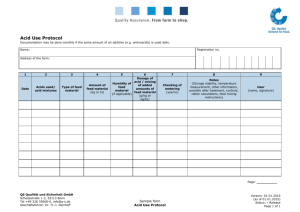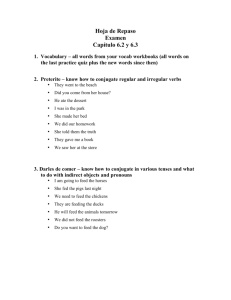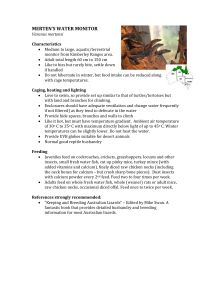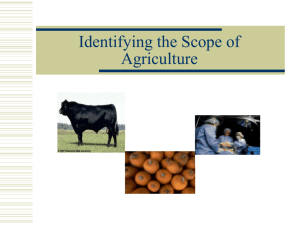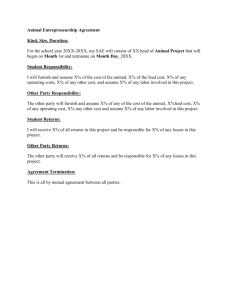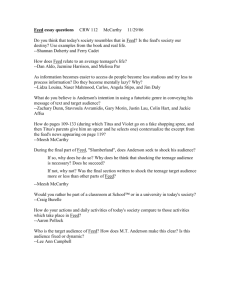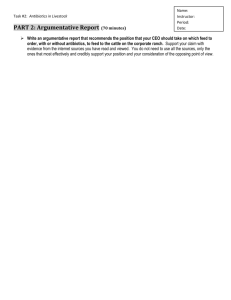ALAT Chapter 6
advertisement
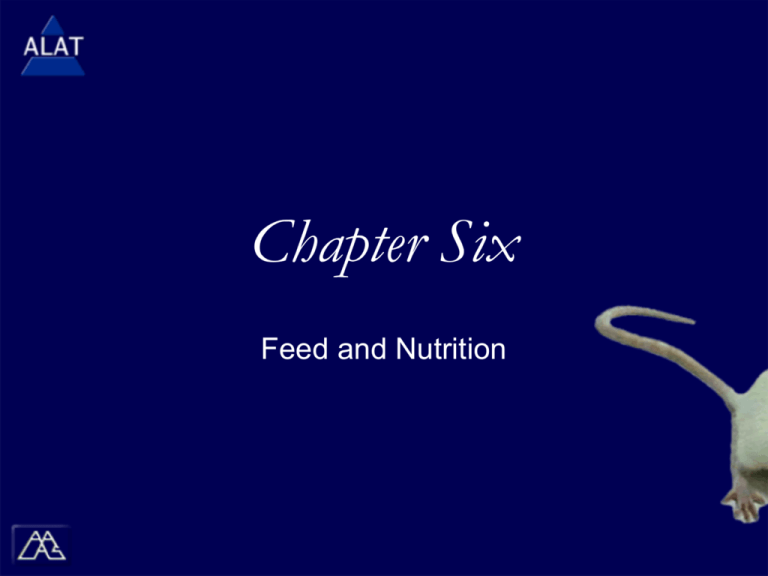
Chapter Six Feed and Nutrition ALAT Presentations Study Tips If viewing this in PowerPoint, use the icon to run the show (bottom left of screen). Mac users go to “Slide Show > View Show” in menu bar Click on the Audio icon: when it appears on the left of the slide to hear the narration. From “File > Print” in the menu bar, choose “notes pages”, “slides 3 per page” or “outline view” for taking notes as you listen and watch the presentation. Start your own notebook with a 3 ring binder, for later study! Feed and Nutrition Raw materials for growth, maintenance & repair Nutrition = food & water requirements & processes to take in & use food Digestion = process food is broken down, absorbed, distributed & made available to cells In cells, chemical reactions break down compounds into simple molecules, releasing energy and molecules for synthesizing new molecules like proteins. The sum of these intracellular chemical reactions is called metabolism. The Nutrients Water, proteins, fats, carbohydrates, vitamins & minerals. Carbohydrates, proteins and fats all provide energy in the form of calories. Organisms require energy to operate. Require essential and nonessential nutrients. Essential nutrients = ones animals can’t produce in sufficient quantities, must be supplied in diet. Essential for some species and not for others. vitamin C for guinea pigs, NHP & humans Some are required in small amounts. vitamins and minerals Water Water is the most important nutrient. An animal can lose reserve carbohydrate and fat and about 50% of body protein and still survive. Without water most animals can survive only a few days. Water is the medium in which all metabolic reactions and body processes take place and is a method for distribution of substances throughout. A loss of approximately 10 to 20% of body water can result in death. Protein Complex molecules made up of long chains of amino acids arranged in a large variety of sequences Proteins are the basic building materials with which tissues are made. Enzymes, some hormones, and hemoglobin are made of proteins. If deficient caloric intake occurs, body protein is metabolized. Fats Structural components of cell membranes More calories than carbohydrates or proteins. One function of fat is to supply and store energy. Provide thermal insulation, cushion and protect organs, store and transport fat-soluble vitamins and synthesize hormones Brown fat is found in some animals, and can be metabolized to provide heat. Broken down into units called fatty acids. Carbohydrates Sugars are elementary forms of carbohydrates. Glycogen = complex sugars easily broken down by enzymes, used as an energy source of body. Carbohydrate is main energy source in metabolism. Excess carbohydrate is stored as glycogen in liver and muscle tissue. When storage areas are full, carbohydrate is converted to fat. Vitamins Function to promote chemical reactions for normal metabolism Non-fatty tissues contain watersoluble vitamins (vitamins C & B). Water-soluble vitamins supplied daily because they are not easily stored. Fat-soluble vitamins A, D, E and K are found in fatty parts of plants and animals. Digestion and metabolism of fat supply fat-soluble vitamins. Fat-soluble vitamins in excess are stored in fat, not excreted. Excess or deficiency vitamin = serious disease Guinea pigs and NHPs get scurvy, a result of feed stored too long or at too high a temperature. Minerals 21 inorganic elements are necessary to sustain life. Ca, P and Na are used as structural components & as electrolytes in salt balance. Minerals are required in trace amounts, & used in a variety of processes. Iron = oxygen carrier in hemoglobin found in RBC. Mineral deficiency or excess in the diet can cause serious disease. Ca is necessary for contraction of muscles, including heart muscle. Deficiency in Ca = poor bones Bone Ca goes to blood to help maintain heart muscle contraction. Energy Metabolism Diets are formulated for each species. Energy is needed to maintain life processes. respiration, cell metabolism, movement, digestion, nerve impulse transmission, cell division & growth 1 calorie is heat necessary to raise temperature of one gram of pure water at 14.5°C to 15.5°C. Feed bag has a chart that tells how many Kcal of energy contained in the diet. can be used to determine how much to feed Feeds vary considerably in total caloric content. carbohydrates = 4.1 Kcal/gram, proteins = 5.6 Kcal/gram and fats = 9.4 Kcal/gram (Images) Dog Eating Feedstuff Evaluation Proximate analysis used to formulate diets. Analytical tests provide data on a feed sample. Consuming proper amount of commercial diet & water = all nutritional requirements. Supplements contribute to daily caloric intake. May result in consuming less than daily diet and interfere with dietary balance. Treats may be a necessity, for delivering medication or for psychological enrichment. Supplementation may be required during rapid growth, pregnancy, lactation or geriatrics. Available Forms of Feed Ground feed = powdered diet Commonly used for poultry but OK for other animals. High dust content may cause respiratory problems in some species Pelleted feed made by grinding and molding into a variety of shapes & sizes. High fat content feeds don’t hold together well. Abundance of powdered feed in the feed bag = questionable quality & should be reported. Fed to rabbits, guinea pigs, rodents and farm animals. Available Forms of Feed II Extruded = high pressure & heat in tapered mold. Semi-moist feed is available for dogs and cats. High calories = unsuitable for caged animal use. May contribute to dental problems. Canned feed is comparatively expensive. Can be used to tempt sick animals to eat or deliver medication by hiding it in the food. Hay given to ruminants, rabbits and guinea pigs. Contaminated hay can affect health. Hay cubes are a suitable alternative. Commercial Diets Standard diets are available with data on protein, fiber, fat or other nutrient content Certified feed measures pesticides & heavy metal contaminants. Contaminants usually certified to be below a particular level. Autoclavable and irradiated feed fed to animals in barrier facilities. Formulated to account for autoclaving which destroys significant portions of certain nutrients. Diets can also be sterilized with radiation. Purified diets are made from ingredients such as starch, glucose, sucrose and casein. Practical Aspects of Feeding Water must be available at all times. A sipper tube may be plugged preventing animal from reaching water, so technician quickly learns to identify such problems and correct them before the animals demonstrate ill effects. Addition of substances to water may cause animals to decrease intake because of taste. Feeders designed for a type of feed. Feed accessible, clean, uncontaminated. J-feeders become clogged with fines. Technicians monitor feed intake & are aware of any variations. Diet & Water Problems Sensitivity to diet changes often fail to eat or exhibit diarrhea make feed changes gradually Growth and reproduction two most demanding physiological states Rodents begin eating feed 10-14 days after birth. Cats and dogs begin to eat at 3-4 weeks old. Extra feed should be provided to the nursing female. Food and Water Intake Animals overactive and distressed within 24 hours without water. Hair coat appears dull and shaggy. Dry food intake decreases dramatically, as does the production of urine and feces Dehydration also due to a disease or faulty watering. Decreased food intake = significant weight loss, obvious overall debilitation, & prominent skeletal structure. Decreased food intake can also be result of an experimental procedure or a disease process In group-housed animals, a dominant animal may prevent a subordinate animal from reaching food. Feed Storage & Room Management Proper handling vital to health & nutrition. Direct bearing on economics of facility management. Storage environment cool, dry, well ventilated & no direct sunlight. Store on platforms or shelves above floor & at least 6 inches from the wall to allow for cleaning & air circulation. If wood is used, seal to allow proper cleaning. Keep open bags in plastic-lined cans w/ tightfitting lids. Shelf Life Milling date = date food was made. Feed loses nutritional value after shelf life expires. Purified diets & some diets containing vitamin C have a short shelf life (3 months or less). Other types can be stored up to 6 months. Storage under less than optimal conditions (for example, high heat or humidity) shortens shelf life. On receipt, check milling date, mark w/ “use by” Check: clean, dry, unstained, not torn or damaged Reject any of these defects as possible contamination. Store special feeds w/ drugs or chemicals away from regular feed storage room. Store detergents & chemicals separately. Additional Reading Frandson, R.D. Anatomy and Physiology of Farm Animals. 5th ed. Lea and Febiger, Philadelphia, PA. 1992. Nutrient Requirements of Laboratory Animals. 4th ed. National Research Council. 1995. Jurgens, M.H. Animal Feeding and Nutrition. Kendall/Hunt, Inc., Dubuque, IA. 1988.
